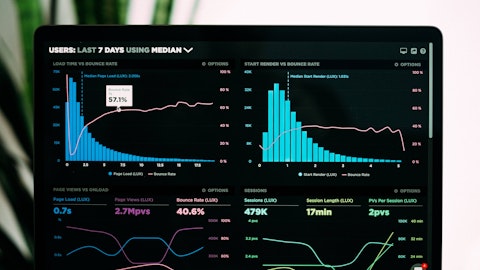Scott McLean: This is Scott. I would just say that we’ve seen line utilization increase a bit. So that is happening, but trying to compare others’ outlooks to ours, is just kind of a function of who they’re talking to, if you roll back a couple of years when loans were pretty flat in the industry and flat for us, everybody was talking about loans, we’re going to definitely start increasing by a certain quarter. And we hesitated saying that and I’m glad we did because they were wrong and we happen to be right on that particular turn, it happened a couple of quarters later. So, I just would go back to what Harris said, it’s very hard to project. I also think that, interest rates, if you look at them historically, they are not especially bad right now.
I mean, if you go back 20, 30, 40 years, they’re generally in-line, so they’re not at especially historically based escalate at high-level. So I don’t know that we have to have interest rates going down the short-term rates to see activity pick up, because it certainly helps some industries. But I don’t think — I don’t think most business folks — commercial business folks are overly anxious about the current level of rates.
Harris Simmons: And I should add — again, I noted earlier, if we see the economy start to pick up, that — I would expect that will, that will help our loan growth. But we do have probably slowing growth in the residential portfolio which is going to offset some of that, that’s probably the reason that we might be a little cautious.
Peter Winter: Okay. And then just one last question. Your economic outlook, you mentioned that improved slightly, you’ve got strong capital. I’m just wondering what are some of the parameters you need to see in order to feel comfortable to kind of resume share buybacks?
Paul Burdiss: Well, I’ll tell you, as it relates to bank capital, there is a lot of uncertainty around the regulatory rules right now. So we’re paying a lot of attention to that. We’re not a Category 4 bank, but we certainly would be, I expect, by the time the proposed capital rules become effective. So, it would be nice to see a little more certainty around what those capital rules are. And even though generally speaking, our credit performance has been excellent. We are feeling a little bit better about the macroeconomic path. We still remain a little cautious. And so over the near-term at least, I wouldn’t expect a large share repurchase.
Harris Simmons: Can I just add? I mean, it’s been actually a long time since we’ve really had a seriously challenging credit cycle. And so even though we’re all kind of thinking probably it’s going to be a soft landing, et cetera, there is enough uncertainty in the world. I think it’s probably time to be a little conservative on the capital front, and especially given what Paul said about that, just rules are in flux, et cetera. So we will be a little careful.
Peter Winter: Got it. Thanks, Harris.
Operator: Thank you. Our next question comes from the line of Chris McGratty with KBW. Please proceed with your question.
Chris McGratty: Great. Thanks for the question. Paul, maybe a high-level question on the margin. You had a peer last week talk about kind of a 3% plus NIM, similar company, balance sheet size and mix. It feels like that’s kind of the trajectory you guys are messaging, given the balance sheet dynamics. I’m just kind of interested if you would agree, kind of what the overall level of when margins may be going?
Paul Burdiss: Well, in my experience, the net interest margin is extraordinarily difficult to predict, because there are so many factors. In our case, I think what we’re demonstrating is, pretty stable net interest income and declining earning assets. And so you do the math on that and the expectation is some modest improvement in the margin.
Chris McGratty: Okay. Perfect. And then, I just want to make sure I understand all the slides, the sensitivities that you provided, which are helpful. If I kind of zoom out, I mean, the ideal rate environment for Zions going into ’24 and we’ve talked about higher for longer and also the Fed curve, the forward curve. What would be kind of the dial-up if you could have it your way?
Paul Burdiss: Well, again our modeling is showing a pretty balanced position. So, I certainly like to think that we will be a little agnostic as it relates to the — your ultimate path and curve shape. We’ve — through portfolio layer swaps, we have worked to hedge our tangible common equity to a spike higher in rates on the longer end of the curve. And then as I said on the shorter end of the curve, we feel with the distribution of deposits that we have, that we would be able to adjust deposit pricing on those very high-price deposits pretty quickly on the downside. And so again it’s a pretty deliberate construction of the hedging program to manage the balance sheet in an uncertain interest rate environment. And so I — a long way of saying that I wouldn’t necessarily pick a best path for us. If we’ve done what we think we’re doing, well, then we should be pretty agnostic to rates.
Scott McLean: Yeah. I just — I would only add, if we saw rates come down [1.5 points] (ph) or something like that, it’d be a great thing for borrowers. And so I think it does matter in terms of our borrowers. And so I’ve always thought to kind of three on the short-end and five on the long-end is about nirvana for a company like ours.
Chris McGratty: That’s awesome. Thank you.
Scott McLean: Thanks.
Operator: Thank you. Our next question comes from the line of Brandon King with Truist Securities. Please proceed with your question.
Brandon King: Hey, good evening. Thanks for taking my questions. So I understand that the use of your liquidity position to kind of run it down to pay for it at loan growth and other uses of funds. But is there a certain floor that you’re thinking when you think about your cash position, money market investments?
Paul Burdiss: Well, yeah, so on cash and money market, I think you see us probably at around $2 billion or so, given the size and composition of the balance sheet. It’s pretty close to where we’re running today. We don’t — it’s cash in sort of in the traditional sense, therefore it’s immediate liquidity. But we feel very confident in our ability to draw on the liquidity embedded in our investment portfolio through the repo in other markets.





